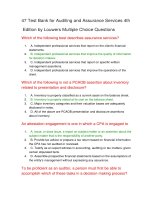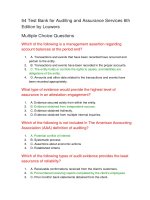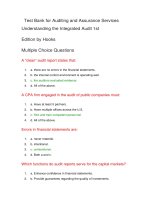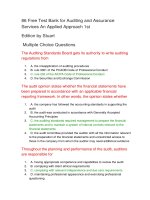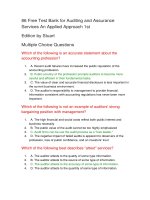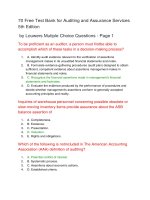99 test bank for auditing and assurance services an applied approach 1st
Bạn đang xem bản rút gọn của tài liệu. Xem và tải ngay bản đầy đủ của tài liệu tại đây (130.82 KB, 32 trang )
Test Bank for Auditing and Assurance Services An
Applied Approach 1st
True False Questions
An important requirement of the auditing standards is that the auditor gather
sufficient appropriate evidence to determine whether the financial statements
have been prepared by competent individuals.
1.
True
2.
False
At the conclusion of the audit, the auditor issues an audit opinion to the SEC.
1.
True
2.
False
The relationship of the audit firm to the client can be described as the
framework of an employer-employee relationship.
1.
True
2.
False
The Auditing Standards Board was formed in 1978 as an equal organization to
the American Institute of Certified Public Accountants (AICPA).
1.
True
2.
False
The auditor structures the evidence process by considering the assertions
made by a consultant in preparing the financial statements of the company.
1.
True
2.
False
An accounting cycle involves both balance sheet and income statement
accounts and follows transactions through a process where it begins to its
conclusion.
1.
True
2.
False
For public companies, management typically prefers lower net income.
1.
True
2.
False
Auditing is the process of reviewing the financial information prepared by the
management of the company.
1.
True
2.
False
Today's auditors play a crucial role in business and society.
1.
True
2.
False
The Securities Act of 1933 and the Securities Exchange Act of 1934 were
designed to restore investor confidence in the capital markets.
1.
True
2.
False
Some of the services that fall under attestation standards are reports on: (1)
descriptions of systems of internal controls, and (2) tax return preparation.
1.
True
2.
False
Multiple Choice Questions - Page 1
Which of the following will allow a company to report higher net income?
1.
A. recording fictitious expenses at the beginning of the year
2.
B. recording fictitious revenue at the end of the year
3.
C. depreciating long lived assets
4.
D. increasing a line of credit at a bank
Throughout the planning and performance of the audit, auditors are
responsible for
1.
A. having appropriate competence and capabilities to review the audit
2.
B. complying with client ethical requirements
3.
C. complying with relevant independence and fraud detection requirements
4.
D. maintaining professional skepticism and exercising professional judgment
The areas where management is more likely to misstate transactions are
riskier for the auditor because
1.
A. the auditor will be the subject of legal action.
2.
B. the auditor probably will not have enough time to identify these areas.
3.
C. failing to correct the misstatements may lead to issuing a clean opinion on materially
misstated financial statements.
4.
D. failing to correct the misstatements may lead to issuing a qualified opinion on
materially misstated financial statements.
Throughout the planning and performance of the audit, auditors are
responsible for
1.
A. having appropriate competence and capabilities to review the audit
2.
B. complying with relevant ethical requirements
3.
C. complying with relevant independence and fraud detection requirements
4.
D. maintaining professional appearance and exercising professional questioning
Which of the following best describes "attest" services?
1.
A. The auditor attests to the quality of some type information.
2.
B. The auditor attests to the source of some type of information.
3.
C. The auditor attests to the accuracy of some type of information.
4.
D. The auditor attests to the quantity of some type of information.
Which of the following is an incorrect statement about auditors' professional
duties?
1.
A. In their professional duties, they will be watched by federal and state regulators and
interested outsiders
2.
B. Attention will be focused on the auditors' responsibility to determine whether the
financial statements present fairly the financial position of the firm and the results of
operations
3.
C. Auditors must understand the importance of presenting unbiased information to
outsiders
4.
D. The auditor is expected to approach an audit with an independent mind and to
recognize that he or she is hired to protect the interests of management
One of the differences between a corporate form of organization and
partnership form is:
1.
A. Someone in the corporate form has personal liability.
2.
B. Corporations can have offices in only one state.
3.
C. Someone in the partnership form has personal liability.
4.
D. Partnerships can have offices in only one state.
The three standard setting organizations that are involved in establishing
auditing standards are
1.
A. The American Association of Accountants, the Auditing Standards Board, and the
Public Company Accounting Oversight Board
2.
B. The International Auditing and Assurance Standards Board, the Auditing Standards
Board, and the Public Company Accounting Oversight Board
3.
C. The American Association of Accountants, the Auditing Standards Board, and the
International Auditing and Assurance Standards Board
4.
D. The Auditing Standards Board, the International Auditing and Assurance Standards
Board, and the Public Company Accounting Oversight Board
To obtain reasonable assurance, which is a high, but not absolute level of
assurance, the auditor:
1.
A. performs the work and properly supervises the client
2.
B. assumes appropriate materiality level or levels
3.
C. identifies and assesses risks of material misstatement, whether due to fraud or
error, based on an understanding of the entity and its environment, including the entity's
internal control
4.
D. obtains sufficient appropriate management representations about whether material
misstatements exist
Which of the following is not an important part of the audit process?
1.
A. understanding incentives of the company to misstate the financial statements
2.
B. identifying the financial statement accounts with the greatest potential for
misstatements
3.
C. documenting management's efforts to achieve the necessary requirements to gain a
bank loan
4.
D. designing audit procedures to determine that the accounts are fairly presented
according to the applicable financial reporting framework
Which of the following is a characteristic of the person doing the assessment
of the financial statements?
1.
A. The person completing the assessment is not an employee of the company.
2.
B. The person completing the assessment works for an accounting firm that is
associated with the company in a role of being hired to perform an internal audit.
3.
C. The person performing the assessment may be a banker, current or potential
stockholder, or a regulatory body.
4.
D. The person performing the assessment makes adjustments to the decisions
recorded by the firm so that outsiders have accurate information to make decisions.
One of the characteristics of a principal-agent relationship is:
1.
A. The owners of the company are not involved in the daily management of the
company.
2.
B. The owners of the company hire an auditor to run the company for them and to
make daily decisions for the company.
3.
C. The owners have more knowledge than management about the daily operations of
the company.
4.
D. Outsiders benefit when a manager is hired by owners to protect their interests in the
company because the information available to outsiders is more likely to correspond to
financial accounting standards.
To obtain reasonable assurance, which is a high, but not absolute level of
assurance, the auditor:
1.
A. performs the work and properly supervises the client
2.
B. determines appropriate materiality level or levels
3.
C. identifies and assesses risks of due to fraud based on an understanding of the entity
and its environment, including the entity's internal control
4.
D. obtains sufficient appropriate management representations about whether material
misstatements exist
Throughout the planning and performance of the audit, auditors are
responsible for
1.
A. having appropriate competence and capabilities to perform the audit
2.
B. complying with client ethical requirements
3.
C. complying with relevant independence and fraud detection requirements
4.
D. maintaining professional appearance and exercising professional questioning
To obtain reasonable assurance, which is a high, but not absolute level of
assurance, the auditor:
1.
A. performs the work and properly supervises the client
2.
B. assumes appropriate materiality level or levels
3.
C. identifies and assesses risks of fraud based on an understanding of the entity and
its environment, including the entity's internal control
4.
D. obtains sufficient appropriate audit evidence about whether material misstatements
exist
To obtain reasonable assurance, which is a high, but not absolute level of
assurance, the auditor:
1.
A. plans the work and properly supervises any assistants
2.
B. assumes appropriate materiality level or levels
3.
C. identifies and assesses risks of fraud based on an understanding of the entity and
its environment, including the entity's internal control
4.
D. obtains sufficient appropriate management representations about whether material
misstatements exist
Which of the following is not an example of auditors' strong bargaining
position with management?
1.
A. The high financial and social costs reflect both public interest and business
necessity
2.
B. The public value of the audit cannot be too highly emphasized
3.
C. Audit firms can be use the audit process as a "loss leader."
4.
D. The negative impact of failed audits is apparent to observers of the profession, loss
of public confidence, and an investors' trust
Throughout the planning and performance of the audit, auditors are
responsible for
1.
A. having appropriate competence and capabilities to review the audit
2.
B. complying with client ethical requirements
3.
C. complying with relevant independence and due care requirements
4.
D. maintaining professional appearance and exercising professional questioning
The principle reason(s) for public companies to misstate financial statements
is to
1.
A. minimize the amount of taxes owed by the company.
2.
B. maximize the amount of dividends paid to shareholders.
3.
C. satisfy the requirement of a going concern.
4.
D. keep the company's stock price from falling.
The audit opinion states whether the financial statements have been prepared
in accordance with an applicable financial reporting framework. In other
words, the opinion states whether
1.
A. the company has followed the accounting standards in supporting the audit
2.
B. the audit was conducted in accordance with Generally Accepted Accounting
Principles
3.
C. the auditing standards required management to prepare the financial statements
and to maintain a system of internal controls relevant to the financial statements
4.
D. the audit committee provided the auditor with all the information relevant to the
preparation of the financial statements and unrestricted access to those in the company
from whom the auditor may need additional evidence
One of the characteristics of a principal-agent relationship is:
1.
A. The owners of the company are involved in the daily management of the company.
2.
B. The owners of the company hire an auditor to run the company for them and to
make daily decisions for the company.
3.
C. The owners have more knowledge than management about the daily operations of
the company.
4.
D. Outsiders benefit when an auditor is hired by owners to protect their interests in the
company because the information available to outsiders is more likely to correspond to
financial accounting standards.
Which of the following is an accurate statement about the accounting
profession?
1.
A. Recent audit failures have increased the public reputation of the accounting
profession.
2.
B. Public scrutiny of the profession prompts auditors to become more careful and
efficient in their fundamental tasks.
3.
C. The value of clear and accurate financial disclosure is less important in the current
business environment.
4.
D. The auditor's responsibility to management to provide financial information
consistent with accounting regulations has never been more important.
Which of the following is a characteristic of the person doing the assessment
of the financial statements?
1.
A. The person completing the assessment is an employee of the company.
2.
B. The person completing the assessment works for an accounting firm that is
associated with the company only in a role of being hired to perform an audit.
3.
C. The person performing the assessment may be a banker, current or potential
stockholder, or a regulatory body.
4.
D. The person performing the assessment makes adjustments to the decisions
recorded by the firm so that outsiders have accurate information to make decisions.
Growth in revenue is an important factor for many companies. The desired
outcome in many businesses is for revenue and possibly net income to
increase at a rate at least equal to the prior year's increase. Which of the
following best explains this desire?
1.
A. If the company does not meet this level of growth, it is an indication that the
company may not be able to meet the dividend expectations of investors
2.
B. Outsiders, particularly stockholders expect this level of growth, and if companies fail
to meet these targets, their stock price may drop as investors sell their stock and find
other companies who can meet the growth level desired
3.
C. Management is concerned that failure to achieve expected levels of growth may
result in management not receiving anticipated bonuses
4.
D. Management is concerned that if the company does not achieve the expected
increase in growth, that the auditors will demand a higher fee and expend greater effort
in attempting to find misstatements in the financial statements
The Preface to the Auditing Standards describes the fundamental principles
that govern an audit. According to these principles, the purpose of an audit is
1.
A. to provide reasonable assurance that there are no misstatements in the financial
statements
2.
B. to plan the audit to provide reasonable assurance of detecting fraud
3.
C. to ensure that the financial statements are fairly presented
4.
D. to increase the level of confidence that outsiders place in the financial statements
The Auditing Standards Board gets its authority to write auditing regulations
from
1.
A. the misapplication of auditing procedures
2.
B. rule 3001 of the PCAOB Code of Professional Conduct
3.
C. rule 202 of the AICPA Code of Professional Conduct
4.
D. the Securities and Exchange Commission
One of the characteristics of a principal-agent relationship is:
1.
A. The owners of the company are involved in the daily management of the company.
2.
B. The owners of the company hire an agent to run the company for them and to make
daily decisions for the company.
3.
C. The owners have more knowledge than management about the daily operations of
the company.
4.
D. Outsiders benefit when a manager is hired by owners to protect their interests in the
company because the information available to outsiders is more likely to correspond to
financial accounting standards.
86 Free Test Bank for Auditing and Assurance
Services An Applied Approach 1st Edition by Stuart
Multiple Choice Questions - Page 2
Which of the following is not a type of evidence gathered by the auditor?
1.
A. substantive evidence
2.
B. internal control evidence
3.
C. factual evidence
4.
D. analytical procedure evidence
The PCAOB is required to
1.
A. conduct continuing inspections of public accounting firms registered with the SEC
2.
B. inspect firms with more than 100 public clients on an annual basis
3.
C. inspect firms with fewer than 100 clients at least every four years
4.
D. post the inspection reports on the SEC website and are available to the public
The PCAOB is required to
1.
A. conduct continuing inspections of public accounting firms registered with the SEC
2.
B. inspect firms with more than 1000 public clients on an annual basis
3.
C. inspect firms with fewer than 1000 clients at least every three years
4.
D. post the inspection reports on the website for the PCAOB and are available to the
public
Professional skepticism is closely linked to due professional care. For an
auditor to gather evidence with due professional care, he or she must perform
the audit with an attitude of professional skepticism. Which of the following
best describes professional skepticism?
1.
A. an attitude of professional skepticism is present when the auditor maintains a
questioning mind and makes a critical assessment of the interviews gathered
2.
B. professional skepticism is used in the planning stage to determine the evidence to
be gathered and the interpretation of the evidence
3.
C. if the auditor applies the concept of professional skepticism, he should be able to
obtain reasonable assurance that the financial statements are free from material
misstatements
4.
D. professional skepticism assumes that the client is dishonest
An important requirement of the auditing standards is that the auditor
1.
A. have no contact with the audit committee of the board of directors
2.
B. use the work of the internal audit staff
3.
C. assist management in the preparation of the financial statements
4.
D. gather sufficient appropriate evidence
Which of the following is correct about the PCAOB?
1.
A. The PCAOB receives its authority from the SEC
2.
B. Auditing standards issued by the PCAOB must be approved by the U.S. Congress
3.
C. The PCAOB requires companies with stock listed on a U.S. stock exchange to have
an integrated audit by an auditor registered with the PCAOB
4.
D. All audit firms performing audits of public companies are registered with and agree
to comply with the auditing procedures established by the PCAOB
When management presents the financial statements to the auditor,
management makes several assertions about the financial statements. Which
of the following is not one of these assertions?
1.
A. residence
2.
B. valuation and allocation
3.
C. accuracy
4.
D. classification
Which of the following statements describe an analytical procedure?
1.
A. Analytical procedures are a form of evidence gathered by the auditor
2.
B. Analytical procedures are calculations of financial amounts
3.
C. Analytical procedures are a comparison of last year's unaudited financial statements
with the current year's audited statements
4.
D. Analytical procedures are a form of internal control audit procedure
Which of the following statements describe an analytical procedure?
1.
A. Analytical procedures are a form of evidence gathered by the client
2.
B. Analytical procedures are calculations of financial amounts
3.
C. Analytical procedures are a comparison of last year's audited financial statements
with the current year's unaudited statements
4.
D. Analytical procedures are a form of internal control audit procedure
The auditor must gather evidence guided by the standard of due professional
care. Due professional care requires
1.
A. the auditor to perform audit duties with skill comparable to that of any other client
2.
B. to gather evidence and interpret evidence in a manner that any other auditor would
have done
3.
C. the auditor to know accounting and auditing requirements
4.
D. the auditor to be knowledgeable about the economy
The revenue business process would include procedures for
1.
A. initiating a proposal
2.
B. shipping the goods or providing a service
3.
C. invoicing the vendor
4.
D. making payment for the sale
The Securities Exchange Commission (SEC) has oversight authority over the
PCAOB. Which of the following is not within the SEC's oversight authority?
1.
A. The SEC approves the PCAOB's rules
2.
B. The members of the PCAOB are appointed by the SEC
3.
C. The SEC approves the PCAOB's budget
4.
D. The SEC determines which audit firms will be inspected by the PCAOB
The Public Companies Accounting Oversight Board (PCAOB) is
1.
A. a for profit public company
2.
B. a government entity
3.
C. private sector non profit organization
4.
D. a non profit public company
The International Auditing and Assurance Standards Board
1.
A. is the standard-setting board for the International Federation of Accountants
2.
B. is a committee of the AICPA
3.
C. reports directly to the SEC
4.
D. adjusts international standards to U.S. GAAP
Which of the following would not be considered audit evidence?
1.
A. the information in the accounting records
2.
B. the records of initial entries
3.
C. supporting explanations
4.
D. general and subsidiary ledgers of the company
A practicing auditor uses the material contained in the auditing standards to
determine all but which of the following?
1.
A. the procedures performed
2.
B. the risk assessed
3.
C. the evidence gathered
4.
D. the audit report issued
The auditor is unable to obtain absolute assurance that the financial
statements are free from material misstatement because of inherent
limitations, which arise from
1.
A. the nature of financial reporting
2.
B. the selection of audit procedures
3.
C. the client's requirement for the audit to be conducted within a reasonable period of
time and at a reasonable cost
4.
D. the fact that there is no such thing as absolute assurance
Which of the following would not be considered audit evidence?
1.
A. the information in the accounting records
2.
B. the estimates of initial entries
3.
C. supporting documents
4.
D. general and subsidiary ledgers of the company
When management presents the financial statements to the auditor,
management makes several assertions about the financial statements. Which
of the following is not one of these assertions?
1.
A. existence or occurrence
2.
B. evaluation
3.
C. accuracy
4.
D. classification
The auditor is unable to obtain absolute assurance that the financial
statements are free from material misstatement because of inherent
limitations, which arise from
1.
A. the structure of financial reporting
2.
B. the nature of audit procedures
3.
C. the client's requirement for the audit to be conducted within a reasonable period of
time and at a reasonable cost
4.
D. the fact that there is no such thing as absolute assurance
Tests of controls are typically done on transactions
1.
A. for the entire year for an audit of the financial reporting process
2.
B. at the end of the year for a Sarbanes-Oxley financial statement audit
3.
C. at the end of the year for a Sarbanes-Oxley financial reporting process
4.
D. of balances on the year-end balance only
Before the creation of the PCAOB, the auditing standards of the Auditing
Standards Board were used to audit all companies. Which statement best
describes the PCAOB and auditing standards?
1.
A. In 2003, the PCAOB adopted certain auditing standards of the ASB as interim
standards
2.
B. In 2003, the PCAOB developed over 100 new auditing standards
3.
C. In 2003, the PCAOB developed audit standards to audit all companies, private and
public
4.
D. In 2003, the PCAOB adopted all the standards of the AICPA to save time in the
development of new standards
Management is responsible for
1.
A. gathering sufficient evidence
2.
B. the preparation of the financial statements
3.
C. determining that the financial statements have been prepared in accordance with
the applicable financial reporting framework
4.
D. approving the audit plan
Substantive tests of transactions are typically done on transactions
1.
A. for the entire year for a financial statement audit
2.
B. at the end of the year for a Sarbanes-Oxley financial statement audit
3.
C. at the end of the year for a Sarbanes-Oxley financial reporting process
4.
D. of balances for the entire year
Professional skepticism is closely linked to due professional care. For an
auditor to gather evidence with due professional care, he or she must perform
the audit with an attitude of professional skepticism. Which of the following
best describes professional skepticism?
1.
A. an attitude of professional skepticism is present when the auditor maintains a
questioning mind and makes a critical assessment of the evidence gathered
2.
B. professional skepticism is used in the planning stage determine the evidence to be
gathered and the interpretation of the evidence
3.
C. if the auditor applies the concept of professional skepticism, he should be able to
obtain assurance that the financial statements are free from material misstatements
4.
D. professional skepticism assumes that the client is dishonest
Which of the following is correct about the PCAOB?
1.
A. The PCAOB receives its authority from U.S. Federal Law
2.
B. Auditing standards issued by the PCAOB must be approved by the U.S. Congress
3.
C. Anyone who wants to purchase stock on a U.S. stock exchange must follow the
rules of the SEC
4.
D. All audit firms performing audits of public companies are registered with and agree
to comply with the auditing procedures established by the PCAOB
The auditor is responsible for
1.
A. the preparation of the financial statements
2.
B. preparing adjustments to the accounting records
3.
C. gathering sufficient appropriate evidence
4.
D. advising management on accounting matters
Which of the following would not be considered audit evidence?
1.
A. the information in the accounting records
2.
B. the records of initial entries
3.
C. supporting documents
4.
D. general and subsidiary worksheets of the company
If the financial statements do not present fairly the financial condition of the
firm in accordance with applicable financial reporting framework, the auditor
should
1.
A. calculate the correct number and make an adjustment to the financial statements
2.
B. advise management of the discrepancy and stop auditing until the discrepancy is
corrected
3.
C. gather sufficient evidence to arrive at the correct financial statement number
4.
D. review the risk assessment and make any necessary revisions
Tests done by the auditor that are referred to as internal control tests
determine whether
1.
A. the financial statements are materially misstated
2.
B. the balance sheet is materially misstated
3.
C. the internal controls are the responsibility of management
4.
D. the internal controls of the company prevent or detect misstatements in the financial
statements
Which of the following is correct about the PCAOB?
1.
A. The PCAOB receives its authority from the SEC
2.
B. Auditing standards issued by the PCAOB must be approved by the U.S. Congress
3.
C. Anyone who wants to purchase stock on a U.S. stock exchange must follow the
rules of the SEC
4.
D. All audit firms performing audits of public companies are registered with and agree
to comply with the auditing standards established by the PCAOB
Substantive tests of balances are performed to gather evidence on
1.
A. income statement accounts
2.
B. balance sheet accounts
3.
C. depreciation expense
4.
D. salaries expense
Professional skepticism is closely linked to due professional care. For an
auditor to gather evidence with due professional care, he or she must perform
the audit with an attitude of professional skepticism. Which of the following
best describes professional skepticism?
1.
A. an attitude of professional skepticism is present when the auditor maintains a
questioning mind and makes a critical assessment of the interviews gathered
2.
B. professional skepticism is used in the planning stage to determine the evidence to
be gathered and the interpretation of the evidence
3.
C. if the auditor applies the concept of professional skepticism, he should be able to
obtain assurance that the financial statements are free from material misstatements
4.
D. professional skepticism neither assumes that the client is dishonest nor that the
client is honest
Substantive tests answer the question
1.
A. Do the financial statement accounts present fairly the financial condition of the firm?
2.
B. Is the amount stated in the account accurate?
3.
C. Are all transactions included in the account?
4.
D. Are all transactions in the account in the proper period?
When management presents the financial statements to the auditor,
management makes several assertions about the financial statements. Which
of the following is not one of these assertions?
1.
A. existence or occurrence
2.
B. valuation and allocation
3.
C. accuracy
4.
D. categorization
The revenue business process would include procedures for
1.
A. initiating a sale
2.
B. storing the goods
3.
C. invoicing the vendor
4.
D. making payment for the sale
The auditor must gather evidence guided by the standard of due professional
care. Due professional care requires the auditor
1.
A. to perform audit duties with skill comparable to that of any other auditor
2.
B. to gather statements and interpret statements in a manner that any other
professional would have done
3.
C. to know accounting and auditing requirements
4.
D. to be knowledgeable about the economy
The PCAOB is required to
1.
A. conduct continuing inspections of public accounting firms registered with the SEC
2.
B. inspect firms with more than 100 public clients on a semi-annual basis
3.
C. inspect firms with fewer than 100 clients at least every three years
4.
D. post the inspection reports on the SEC website and are available to the public


